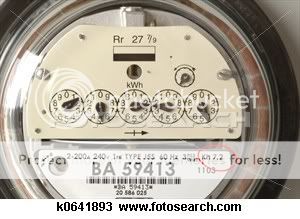(quoted from post at 09:19:57 03/23/12)
(quoted from post at 09:09:25 03/23/12)
(quoted from post at 21:12:50 03/22/12)
(quoted from post at 22:02:09 03/22/12) I'd like to get some amp readings off my power service to the shop without removing the cover and using the hand held clamp-meter. I recall making a simple amp meter years ago by wrapping a strand of wire around the line and hooking it to a voltmeter. It's just a crude transformer. But that was only a few amps, I'd like to make a larger one to measure 200A. Meter CT's for that size are expensive, anyone have a lead on how to make your own?
oes your power meter have the flat aluminum disk with the black mark of it that can be seen spinning faster & faster with more load?
If yes, I can tell you how to use it to measure what you want, excepting pf?
I would interested in how you can measure the draw,if not too much trouble?
Tom
I suggest that you take a more direct approach and measure the Watts passing through your electric meter. Not only will you be able to see parasitic current draw (everything in house turned off & unplugged), but you will be able to measure the power consumption of any one electrically powered device in you home whether it be a light bulb (point of reference for your meter), hot water heater (both measure & see it cycling on/off), air conditioner/heat pump, or anything electric that you have in your home. You can compare your 'reading' with the stated name plate draw (Watts) of the device/appliance.
If your meter looks like the picture, you will see a spinning disk of aluminum partially protruding through the face plate below the dials. Circled in red is a number called the "K sub h" factor & units are watt-hours per revolution. Here it is 7.2. Your meter might be 3.6 or some other number. Use the number on your meter. This disk will turn one revolution in one hour if the power being used is 7.2 watts.
To obtain your power useage at any time, you use your watch with sweep second hand and count the number of disk revolutions in one minute & write that number down as 'revolutions per minute'. Multiply that number by 7.2 (or 3.6 or whatever is on your meter). Next multiply that result by 60. The final result is equal to the power in Watts being used by everything in your home at the moment of your measurement.
(rev/min) X (K sub h) X 60 = Watts
or
(rev/min) X (Watt-hr/rev) X (60min/hr) = Watts


